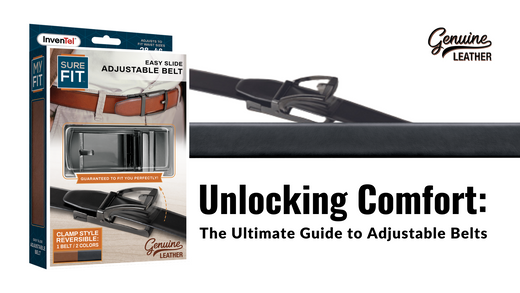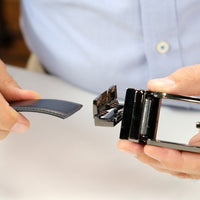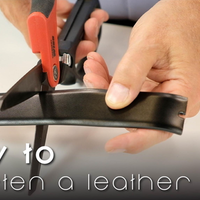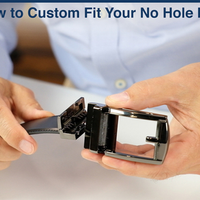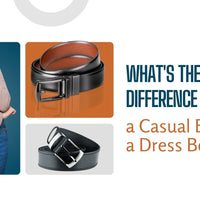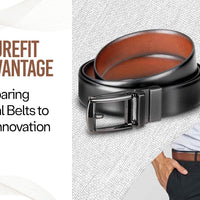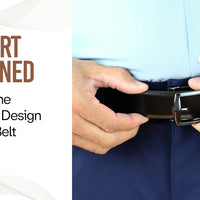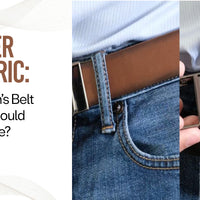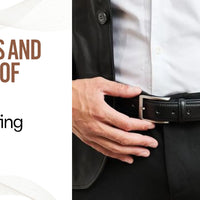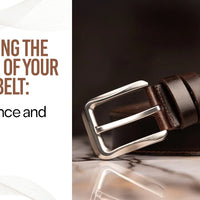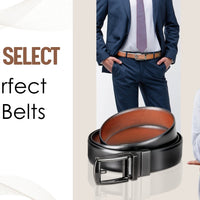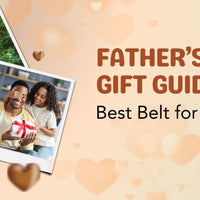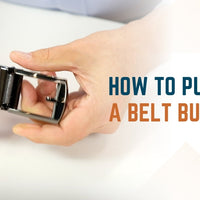Belts are an essential accessory that not only serves a functional purpose but also adds a touch of style to your outfit. A comfortable belt is crucial for ensuring that you can go about your day with ease and without any discomfort.
This comprehensive guide will provide you with everything you need to know about adjustable belts, helping you unlock the ultimate comfort.
The Importance of a Comfortable Belt
Comfort is key when it comes to wearing a belt. A well-fitted, comfortable belt can make all the difference in your daily activities. It ensures that your pants stay in place without being too tight or too loose, allowing you to move freely and comfortably.
When choosing a belt, it's important to consider the material and width. Leather belts are a popular choice as they are durable and can easily be dressed up or down. The width of the belt should correspond to the belt loops on your pants – a belt that is too wide or too narrow may not fit properly.
It's also essential to find a belt with the right closure mechanism. Whether it's a buckle, clasp, or snap closure, make sure it is secure and easy to adjust. A belt that constantly comes undone or requires constant readjustment can be annoying and uncomfortable.
 Lastly, consider the overall design and style of the belt. While functionality is important, you also want a belt that complements your outfit and personal style. Whether you prefer a classic leather belt, a statement piece with unique detailing, or a trendy fabric belt, choose one that not only looks good but feels good too.
Lastly, consider the overall design and style of the belt. While functionality is important, you also want a belt that complements your outfit and personal style. Whether you prefer a classic leather belt, a statement piece with unique detailing, or a trendy fabric belt, choose one that not only looks good but feels good too.
Factors to Consider When Choosing an Adjustable Belt
When selecting an adjustable belt, there are several factors to consider. These include the material of the strap, the durability of the buckle, and the overall design of the belt. Additionally, you should choose a belt that fits your waist size perfectly for optimal comfort.
1. Material of the strap:
The material of the belt strap is an important factor to consider when selecting an adjustable belt. Common materials used for belt straps include leather, canvas, nylon, and synthetic materials. Leather belts are known for their durability and classic appearance, while canvas and nylon belts are more lightweight and versatile for casual wear. Choose a material that suits your style and requirements.
2. Durability of the buckle:
The buckle is an essential component of an adjustable belt as it secures the belt in place. It is important to choose a buckle that is durable and can withstand regular use. Look for buckles made from high-quality metal such as stainless steel or zinc alloy for maximum durability.
3. Overall design of the belt:
The design of the belt should complement your personal style and wardrobe. Adjustable belts come in a variety of designs such as simple leather belts, braided belts, woven belts, and reversible belts. Choose a design that suits your aesthetic preferences and can be paired with different outfits.
4. Perfect fit for your waist size:
It is crucial to select an adjustable belt that fits your waist size perfectly for comfort and convenience. Most adjustable belts come in a universal size range that can be easily adjusted to fit various waist sizes. Make sure to measure your waist accurately and choose a belt that can be adjusted to your desired size without compromising on comfort.
By considering these factors when selecting an adjustable belt, you can ensure that you choose a high-quality and comfortable belt that meets your style and functional needs.
How to Determine the Optimal Belt Size for Maximum Comfort
Measuring your waist accurately is crucial in finding the perfect fit for your belt. Ensuring that the belt is neither too tight nor too loose will provide you with the ultimate comfort. An adjustable belt allows you to customize the size to your preference, guaranteeing a snug and secure fit. To measure your waist for a belt, follow these steps:
- Use a flexible measuring tape to measure around your waist where you typically wear your belt. Make sure the tape measure is snug but not too tight.
- Note the measurement in inches or centimeters, depending on the units of the belt sizing.
- When choosing a belt, refer to the size guide provided by the brand or manufacturer. Typically, belt sizes are measured from the end of the buckle to the middle hole of the belt.
- If you are between sizes, it is recommended to size up for a comfortable fit.
- Select a belt with an adjustable sizing option, such as multiple holes or a removable buckle, to customize the fit as needed.
By measuring your waist accurately and selecting a belt with adjustable sizing, you can ensure a perfect fit that will provide comfort and style all day long.
Discovering the Different Types of Belt Buckles
Belt buckles come in various styles and designs, ranging from traditional clasps to modern magnetic closures. Choosing the right buckle style that complements your belt is essential for both functionality and aesthetics. Some popular belt buckle styles include:
1. Traditional Prong Buckle: This is the most common type of belt buckle, featuring a metal frame with a prong that fits into holes on the belt for secure fastening.
2. Click Belt Buckle: Also known as a snap buckle, this type has a mechanism that allows you to easily snap and lock the buckle in place.
3. Western Buckle: Often seen on cowboy belts, western buckles are large, ornate, and typically feature intricate designs or images, such as a Western motif or a cowboy's initials.
4. Slide Buckle: A sleek and minimalist option, slide buckles work by sliding the belt through a loop and tightening it to the desired fit.
5. Magnetic Buckle: Quick and convenient, magnetic buckles use magnets to snap the buckle shut, providing a secure hold without the need for holes.
When choosing a buckle style, consider the material, width, and color of your belt to ensure a cohesive look. Make sure the buckle is compatible with your belt's width and style, as not all buckles will fit all belts. Additionally, think about your personal style and preferences to find a buckle that suits your taste and complements your wardrobe.
Adjusting and Setting up Your Belt for the Best Fit
Adjusting your belt to the correct size is a simple process that can significantly impact your comfort level. Follow the provided instructions to ensure that your belt fits properly and comfortably around your waist. A well-fitted belt can enhance your overall appearance and confidence.
- To adjust your belt, start by looping the belt through your belt loops on your pants or skirt.
-
Put the belt around your waist and fasten the buckle.
-
Check if the belt fits snugly around your waist. It should be comfortable but not too tight or too loose.
-
If the belt is too tight, loosen the buckle by pulling the loose end of the belt away from the buckle. Adjust it to a comfortable fit and then re-fasten the buckle.
-
If the belt is too loose, tighten the buckle by pulling the loose end of the belt towards the buckle. Adjust it to a comfortable fit and then re-fasten the buckle.
-
Double-check the fit of the belt by moving around and sitting down to ensure that it stays in place and remains comfortable.
-
Trim any excess length off the belt if necessary, following the instructions provided by the belt manufacturer.
-
Once you have adjusted the belt to the correct size, wear it with confidence knowing that it complements your outfit and provides the necessary support.
By following these steps, you can ensure that your belt fits properly and comfortably, enhancing your overall appearance and confidence.
Ensuring Your Belt Fits Properly and Safely
A properly fitting belt not only provides comfort but also ensures safety, especially when lifting or handling heavy objects. A secure belt can prevent accidents and injuries, making it a crucial accessory for various activities.
When choosing a belt, it is important to consider the proper size and material. The belt should fit snugly around the waist without being too tight or too loose. It should also be made of a sturdy material that can withstand the weight of the items being lifted.
 In In addition to size and material, the style of the belt can also impact its effectiveness. Belts with buckles that securely fasten and lock in place are ideal for heavy lifting tasks. Additionally, belts with added padding or support can provide extra comfort and protection.
In In addition to size and material, the style of the belt can also impact its effectiveness. Belts with buckles that securely fasten and lock in place are ideal for heavy lifting tasks. Additionally, belts with added padding or support can provide extra comfort and protection.
It is important to regularly check the condition of the belt and replace it if there are any signs of wear and tear. A worn-out or damaged belt can compromise safety and increase the risk of accidents.
Key Takeaways
In conclusion, choosing the right belt that fits is essential for unlocking ultimate comfort and convenience. From selecting the perfect size to adjusting the fit, a high-quality and durable adjustable belt can enhance your daily activities.
By following the guidelines provided in this ultimate guide, you can ensure that your belt meets all your comfort and style needs.

